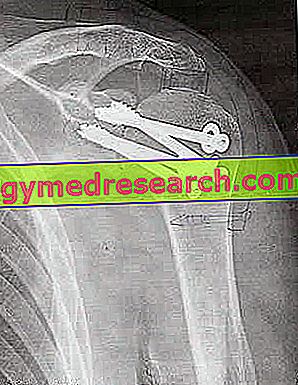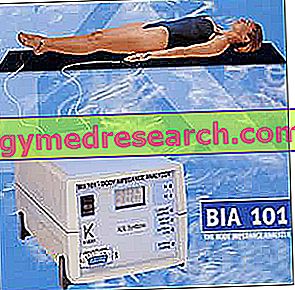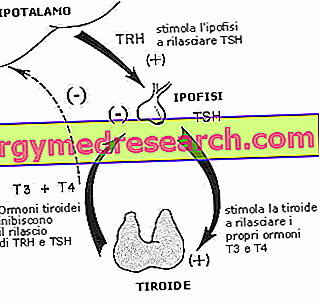Generality
Arthrodesis is the surgical fusion of the bony elements that make up a mobile or semi-mobile joint of the human body.
Doctors use arthrodesis only under certain conditions: when there is severe joint damage and conservative treatments, against the pain induced by such damage, are completely ineffective.

Image from Wikipedia.org
Arthrodesis requires special preparation and includes the typical risks of any major surgery.
Depending on the surgical technique used, an arthrodesis can be an "open" operation or an arthroscopy operation.
Recovery times and rehabilitation vary depending on the joint undergoing surgery.
The results of an arthrodesis depend on the severity of the condition that made the surgery indispensable.
Short anatomical reference on the joints
The joints are anatomical structures, sometimes complex, which put two or more bones in mutual contact. In the human body, there are about 360 of them and their task is to keep the various bone segments together, so that the skeleton can fulfill its function of support, mobility and protection.
The anatomists divide the joints into three main categories:
- Fibrous joints (or synarthrosis ), lacking in mobility and whose bones are joined by fibrous tissue. Typical examples of synarthrosis are the bones of the skull.
- Cartilaginous joints (or amphiarthrosis ), with poor mobility and whose bones are linked by cartilage. Classic examples of amphiartrosis are vertebral vertebrae.
- The synovial joints (or diarthrosis ), provided with great mobility and made up of various elements, including: the so-called articular surfaces, the joint capsule, the layers of cartilage that cover the articular surfaces, the synovial membrane, the synovial bags and a series of ligaments and tendons.
Typical examples of diarthrosis are the joints of the shoulder, knee, hip, ankle, etc.
What is arthrodesis?
Arthrodesis is the surgical procedure through which the doctors carry out the fusion of the bone elements that make up a joint, mobile or semi-mobile, of the human body.
Due to the fusion of the constituent bone elements, the articulation subjected to arthrodesis is transformed from a mobile or semi-mobile element into a static element.
SYNONYMS
Arthrodesis is also known by the alternative names of: surgical ankylosis or joint fusion .
JOINTS OF GREATER INTEREST
Several joints of the human body may be subject to arthrodesis.
In most cases, surgical ankylosis interventions involve the ankle and wrist joints; more rarely, they involve the joints of the fingers, feet and the intervertebral joints (for the fusion of tracts of the spine).
Indications
Arthrodesis is a surgical treatment that doctors take into consideration when there is severe osteo-articular damage and conservative therapies, against the pain induced by the aforementioned damage, have been completely ineffective.
The therapeutic goal of arthrodesis interventions is to reduce pain symptoms ; the means of achieving this goal is the elimination of the painful joint.
Is there an alternative to arthrodesis?
Arthrodesis is not the only surgical solution applicable in the presence of severe osteo-articular damage.
In fact, an alternative intervention exists, which consists in replacing the damaged and extremely painful joint with a prosthesis .
IN WHICH MEDICAL CONDITIONS IS IT INTRODUCED?
The conditions that may require arthrodesis are:
- Severe forms of arthritis . The most common types of arthritis are osteoarthritis (or arthrosis) and rheumatoid arthritis;
- Osteo-articular fractures that have induced osteonecrosis ;
- Osteo-articular deformities, secondary to other diseases, such as rheumatoid arthritis, diabetes, etc. Osteo-articular deformities can be so pronounced that the subjects cannot walk without experiencing pain.
Preparation
A few days before the arthrodesis operation, the patient must undergo a series of medical checks - the so - called pre-operative examinations - and meet with the surgeon who will carry out the operation, to be informed of the characteristics and implications of the operation.
- Duration of the intervention;
- Allergies to drugs that could be used during or after the operation;
- Drugs taken by the patient for the treatment of other morbid conditions;
- Pharmacological therapies that it is good to interrupt in view of the nephrectomy (eg: anticoagulants, antiplatelet agents, NSAIDs etc.);
- Type of anesthesia;
- Duration of admission;
- Characteristics of pre-operative fasting.
PRE-OPERATOR EXAMS
In general, in the case of arthrodesis, pre-operative examinations consist of: blood tests, urinalysis, analysis of vital signs, electrocardiogram and joint radiography which should be the subject of intervention.
The purpose of pre-operative examinations is to clarify the general state of health of the patient (whether or not he is able to face surgery, etc.) and the precise conditions in which the damaged and painful joint is located.
Procedure
Orthopedic surgeons have the opportunity to perform the arthrodesis operation in two different ways: through an "open" operation ( "open" arthrodesis ) and through an arthroscopy operation ( arthroscopic arthrodesis ).
In both cases, just before the actual procedure starts, it is essential to subject the patient to general anesthesia . To deal with general anesthesia, he is a specialized doctor: the so-called anesthesiologist.
General anesthesia: some more details
Readers are reminded that general anesthesia involves the patient falling asleep. Asleep, the patient is completely unconscious and insensitive to pain.
The duration of induced sleep coincides with the duration of the surgical operation: the anesthesiologist administers the anesthetic drugs, which stimulate sleep, until the procedure is finished; with the interruption of anesthetic administrations, the patient awakens.
ARTRODESI "A CIELO OPEN"
"Open sky" arthrodesis involves making an incision of several centimeters in the anatomical area in which the articulation of interest resides.
This incision represents the opening through which the surgeon reaches the painful joint components and fuses them together.
At the end of the procedure, the operating doctor closes the incision through the application of some sutures.
ARTROSCOPIC ARTRODES
Arthroscopy is a minimally invasive surgical technique, which allows surgeons to access a joint, through incisions that are decidedly smaller than those practiced during traditional "open" surgery.
The most representative surgical instrument of arthroscopy is the so-called arthroscope .
Similar to a drinking straw, the arthroscope is constructed for its insertion into the most important joints of the human body and to view the contents of these (thanks to a camera, a light and a connection with an external monitor).
Generally in number of three, arthroscopic incisions allow the introduction not only of the arthroscope, but also of those surgical instruments necessary for the modification and / or repair of the articular elements.
At the end of the procedure, the operating doctor will close the small incisions, through a few stitches.
MERGER OF THE ARTICULATION
Regardless of the method of intervention used, the surgical fusion of a joint can take place by the application of screws, pins, metal implants, the so-called Kirschner wires ( K-wires ) and bone tissue transplants .
As far as bone tissue transplants are concerned, these can be of the autologous type, of the allogeneic type or of the synthetic type:
- Autologous bone transplants . A bone transplant is an autologous type when the bone tissue, used for the remodeling of a specific bone structure of a patient, comes from the same patient.
Autologous transplants are extremely advantageous, because they present a minimal risk (if not zero) of rejection.
Unfortunately, the conditions to execute them do not always exist.
- Allogeneic bone transplants . A bone transplant is an allogeneic type when the bone tissue, used for the purpose of the intervention, comes from another individual (a donor).
Allogeneic transplants present an inconvenient inconvenience: they are at high risk of rejection.
Unlike autologous transplants, it is much more common for the conditions to be fulfilled to exist.
- Synthetic bone transplants . A bone graft is synthetic when the bone tissue, necessary for the arthrodesis operation, has been artificially created in the laboratory.
Artificial bone tissues mimic natural bone tissues with some efficiency, so their use is spreading more and more.
Post-operative phase
Upon awakening from general anesthesia, the patient may experience a more or less marked sense of confusion. This sense of confusion is a normal consequence of the anesthetic drugs used and could last for several hours.
In addition to the sense of confusion, other typical (and quite normal) sensations of the phase immediately following the arthrodesis intervention are:
- Nausea and dizziness. They are another consequence of general anesthesia;
- Pain at the level of the operated area. It is a passing pain, which, if it is particularly annoying, can be effectively alleviated with painkillers;
- Numbness in the operated area. It is a passing problem, which improves over a few hours.
plaster
Some types of arthrodesis (for example, ankle arthrodesis) involve the casting of the operated joint.
HOSPITALIZATION AND RESIGNATION
Generally, surgical operations requiring general anesthesia involve hospitalization for at least one night. During this time, the medical staff keeps the patient under close observation, periodically monitoring vital signs (body temperature, heart rate, blood pressure, etc.).
Doctors strongly advise patients to request help from a close family member or friend for discharge and, above all, return home.
Recovery and rehabilitation
The physiotherapy recovery and rehabilitation phase depends on the articulation subjected to arthrodesis and the intervention modalities (as a rule, the operation in arthroscopy has shorter recovery times than the "open" operation).
In general, in the case of arthrodesis, recovery and rehabilitation have a total duration of several weeks - if not even months - and provide for various recommendations, to which patients must adhere, so that the fusion takes place in the correct ways.
To see how and if arthrodesis is successful, periodic radiographs are provided for the operated joint.
Practical example: ankle arthrodesis
In the case of arthrodesis of the ankle, the recovery and rehabilitation phase generally ends about 12 weeks after surgery.
For at least the first four weeks, the patient must not load the weight on the affected foot; can begin to do so gradually at the beginning of the fifth week.
Between the sixth and eighth week, the cast is removed.
Risks and complications
The most common complications of arthrodesis are the classic ones of any major surgery procedure, namely:
- Infection development;
- Blood loss (hemorrhage) from surgical incisions;
- Allergic reactions to anesthetics;
- Abnormal blood clot formation and increased risk of deep vein thrombosis;
- Injuries of one or more nerve structures.
Among the less common complications of arthrodesis, the failure to merge the joint (failure of the intervention) and the possibility of developing a particular condition, known as compartment syndrome, deserve particular mention.
Results
The results of an arthrodesis depend on how severe the condition that necessitated the surgery is.
STATE IN WHICH THE ARTICLE WORKS
At the end of an arthrodesis operation, the operated joint presents a considerably reduced mobility, compared to before the operation and compared to when the joint was healthy.
This is not surprising, since the wide range of movement enjoyed by some joints of the human body depends precisely on the freedom of the various constituent bony elements to move independently of each other.
In the case of arthrodesis, the joint bones are fused together, forming a single bone.
ALLOWED ACTIVITIES
Arthrodesis subjects have the opportunity to perform most of their work activities.
As far as physical exercise is concerned, the permitted activities vary according to the articulation operated.
For example, an individual subjected to arthrodesis of the ankle can walk for a long time, pedal or ski, but cannot run, jump, etc.



